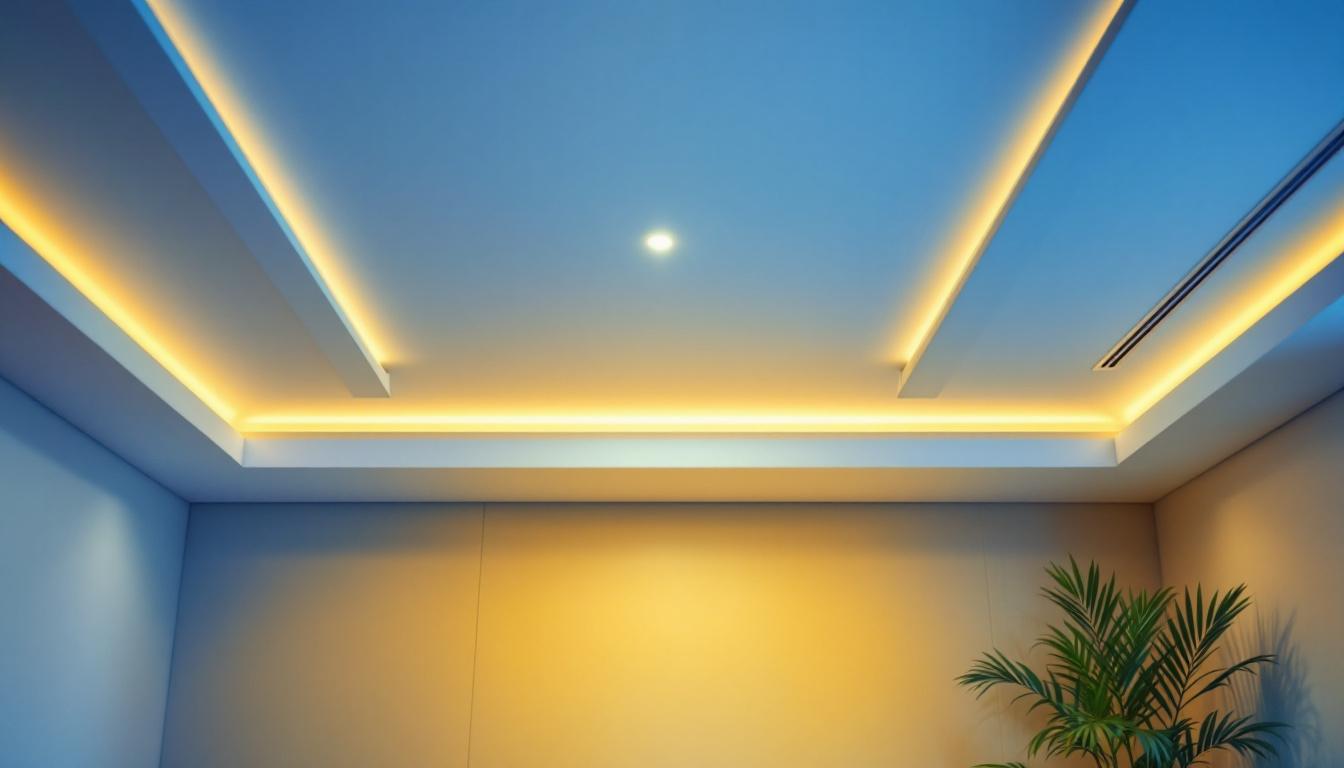
Drop ceilings, also known as suspended ceilings, are a prevalent architectural feature in commercial and institutional buildings. Consisting of a metal grid suspended from the structural ceiling, drop ceilings hold lightweight panels that conceal wiring, ductwork, and plumbing while providing a clean, finished look. For lighting contractors, understanding the unique characteristics of drop ceilings is essential when designing and installing energy-efficient lighting systems.
The presence of a drop ceiling alters how light behaves within a space. The panels reflect and diffuse light differently than traditional ceilings, affecting both the distribution and intensity of illumination. Additionally, the space above the drop ceiling offers an opportunity to integrate lighting fixtures and controls that can enhance energy efficiency without compromising aesthetics or functionality.
Drop ceilings create a distinct environment for lighting professionals to consider. The ceiling height is effectively lowered, which can influence the choice of lighting fixtures and their placement. The grid system provides a convenient framework for installing recessed or lay-in fixtures, but it also imposes size and weight constraints. Moreover, the materials used in ceiling tiles can impact light reflection and absorption, which in turn affects the overall lighting quality and energy consumption.
In addition to these considerations, the color and texture of the ceiling tiles can significantly influence the ambiance of a space. For instance, lighter-colored tiles can enhance brightness and create a more open feel, while darker tiles may absorb more light, leading to a cozier atmosphere. Understanding these nuances allows lighting designers to tailor their approach, ensuring that the chosen fixtures not only illuminate effectively but also complement the overall design aesthetic of the environment.
One challenge contractors face is ensuring that lighting fixtures fit seamlessly within the grid while maintaining easy access for maintenance. Another is optimizing light output to avoid dark spots or glare, which can reduce occupant comfort and productivity. However, these challenges come with opportunities: the plenum space above the ceiling can house advanced lighting controls, sensors, and wiring that contribute to smarter, more energy-efficient systems.
Furthermore, the integration of smart technology into drop ceiling designs opens up new avenues for enhancing energy efficiency. For example, occupancy sensors can be installed in the plenum space to automatically adjust lighting based on the presence of individuals in a room. This not only conserves energy but also extends the lifespan of the fixtures. Additionally, the use of LED lighting in conjunction with drop ceilings can significantly reduce energy consumption while providing high-quality illumination, making it a preferred choice for modern commercial spaces.
Selecting appropriate lighting fixtures is critical for maximizing energy efficiency in drop ceiling environments. The most common types of fixtures used in these settings include recessed troffers, LED panels, and surface-mounted luminaires designed specifically for suspended grids.
LED troffers have become the go-to solution for drop ceiling lighting due to their slim profile, high efficiency, and long lifespan. These fixtures fit neatly into the ceiling grid, replacing traditional fluorescent troffers with significantly reduced energy consumption. LEDs also offer superior color rendering and dimming capabilities, which contribute to a more comfortable and adaptable lighting environment.
Energy savings with LED troffers can be substantial. Studies show that LED lighting retrofits in commercial buildings can reduce lighting energy use by up to 50-70%, depending on the existing system and controls implemented. For lighting contractors, specifying LED troffers with high efficacy (lumens per watt) and quality drivers ensures clients receive the best return on investment.
Moreover, the longevity of LED troffers means less frequent replacements, which not only saves on material costs but also minimizes disruption to the workspace. This is particularly advantageous in busy environments like offices or schools, where downtime can impact productivity. Additionally, many LED troffers are now designed with smart technology integration, allowing for advanced control options such as occupancy sensors and daylight harvesting, further enhancing energy savings and user comfort.
In addition to troffers, LED panels offer a uniform, glare-free light source that works well in offices, classrooms, and healthcare facilities. These panels often feature diffusers designed to optimize light distribution and minimize harsh shadows. Specialty fixtures such as pendant LEDs or surface-mounted luminaires may be used in areas where the drop ceiling grid is not accessible or where architectural design calls for a different aesthetic.
Furthermore, the versatility of LED panels allows them to be used creatively in design, with options for various sizes and shapes that can enhance the visual appeal of a space. For instance, larger panels can be used to create a seamless look across expansive ceilings, while smaller, modular panels can be arranged in unique configurations to add character and style. This adaptability makes LED panels not just functional but also a key element in modern interior design.
When choosing fixtures, contractors must consider factors such as fixture size, lumen output, color temperature, and compatibility with dimming controls. It is also important to verify that fixtures are rated for use in plenum spaces if installed above the ceiling tiles, ensuring compliance with fire and safety codes.
Additionally, the choice of color temperature can significantly influence the ambiance of a space. Warmer tones (around 2700K to 3000K) can create a cozy and inviting atmosphere, making them ideal for residential settings or hospitality environments, while cooler tones (4000K to 5000K) are often preferred in workspaces for their ability to enhance focus and productivity. Understanding the specific needs of the space and its occupants is key to selecting the right lighting fixtures that not only meet functional requirements but also contribute positively to the overall environment.
Lighting controls are a cornerstone of energy-efficient lighting systems, especially in spaces with drop ceilings where occupancy and daylight levels can vary significantly. Proper integration of controls not only reduces energy consumption but also extends fixture lifespan and improves occupant comfort.
Occupancy sensors detect the presence of people and automatically turn lights on or off, preventing energy waste in unoccupied rooms. In drop ceiling installations, sensors can be mounted within or adjacent to fixtures or discreetly placed in the ceiling grid to maintain aesthetics. Combining occupancy sensors with daylight harvesting systems—which adjust artificial lighting based on natural light availability—can further optimize energy savings.
Modern lighting controls include networked systems that allow centralized management, scheduling, and real-time monitoring. Wireless controls integrated into the plenum space above drop ceilings enable easy upgrades and scalability without extensive rewiring. These systems can be programmed to adjust lighting based on time of day, occupancy patterns, or specific user needs, delivering significant reductions in energy use.
Contractors must ensure that lighting controls are compatible with the selected fixtures and that installation allows for straightforward access to sensors and control modules. Proper documentation and labeling within the ceiling plenum facilitate future maintenance and troubleshooting, critical for sustained energy performance.
The materials and colors of ceiling tiles play a vital role in the overall lighting efficiency of a space. High reflectance ceiling tiles can amplify the effectiveness of lighting fixtures by reflecting more light back into the room, reducing the need for higher wattage fixtures.
Ceiling tiles with a reflectance rating of 80% or higher are ideal for energy-efficient lighting designs. These tiles help maximize the utilization of available light, improving uniformity and reducing shadows. Contractors should collaborate with architects and facility managers to select tiles that balance acoustic performance, aesthetics, and reflectance.
Proper fixture spacing and layout are essential to avoid dark spots and glare. Using lighting simulation software can assist contractors in planning fixture placement that complements the reflective properties of ceiling tiles. Additionally, incorporating indirect lighting techniques—such as wall washing or cove lighting—can enhance visual comfort and reduce energy consumption by leveraging reflected light.
Successful implementation of energy-efficient lighting in drop ceiling environments depends on meticulous installation and ongoing maintenance. Lighting contractors play a crucial role in ensuring that systems perform as intended over their lifespan.
During installation, it is important to verify that fixtures are securely mounted within the ceiling grid and that wiring complies with electrical codes. Careful coordination with other trades working in the ceiling plenum prevents damage to lighting components and maintains system integrity. Labeling circuits and control devices clearly supports future maintenance efforts.
Regular maintenance, including cleaning fixtures and replacing worn components, preserves lighting quality and efficiency. Dust and dirt accumulation on ceiling tiles and fixtures can reduce reflectance and light output. Contractors should advise clients on maintenance schedules and provide guidance on using compatible replacement parts to avoid compromising system performance.
For facilities with older lighting systems, retrofitting with LED fixtures and modern controls is a cost-effective way to achieve energy savings. Contractors should conduct thorough assessments to identify compatibility issues and recommend solutions that minimize disruption during upgrades.
Lighting contractors are pivotal in advancing energy efficiency in commercial and institutional buildings through informed design, specification, and installation of lighting systems in drop ceiling environments. By understanding the nuances of drop ceilings, selecting appropriate fixtures, integrating advanced controls, and optimizing light distribution, contractors can deliver solutions that reduce energy consumption, enhance occupant comfort, and meet sustainability goals.
Staying current with evolving technologies and best practices empowers contractors to provide clients with lighting systems that are not only efficient but also adaptable to future needs. The drop ceiling, once seen as a simple architectural element, has become a strategic component in the pursuit of smarter, greener lighting.
Ready to elevate your lighting projects with the most efficient and cost-effective solutions? Look no further than LumenWholesale. Our extensive selection of spec-grade lighting products is designed to meet the unique demands of drop ceiling environments, ensuring you can deliver on both energy efficiency and aesthetic appeal. With unbeatable wholesale prices and the convenience of free shipping on bulk orders, LumenWholesale is your go-to source for premium lighting without the premium price tag. Don’t let hidden fees or markups dim your project’s potential. Wholesale Lighting at the Best Value is just a click away—transform your lighting approach with LumenWholesale today.

Discover how electrical clips play a crucial role in enhancing safety and efficiency in lighting installations.

Discover the essential insights lighting contractors need about LED corn lights.

Discover expert tips and innovative strategies in “Lighting X: Advice for Lighting Contractors” to enhance your projects, boost efficiency, and stay ahead in the competitive lighting industry..

Discover why LED light poles are transforming the landscape for lighting contractors.